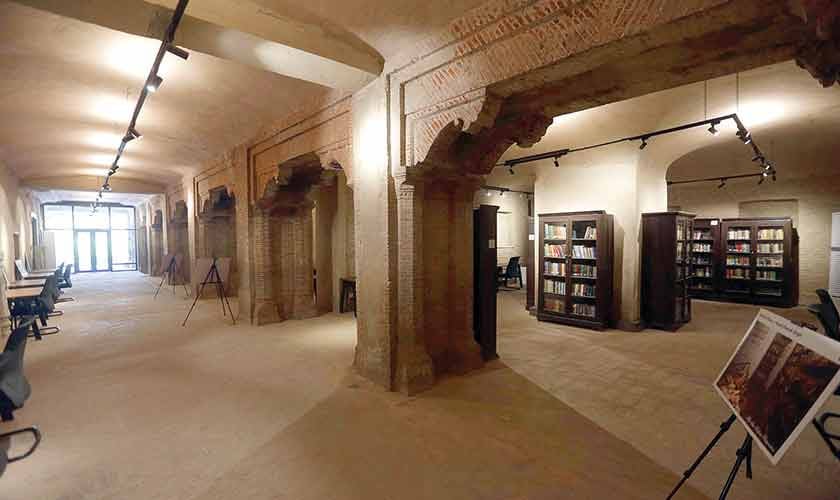**The Forgotten Haveli in Lahore Fort: Kharak Singh’s Legacy Lives On Through Archives**
Tucked inside the Lahore Fort, behind layers of Mughal grandeur and colonial brickwork, lies a structure most visitors overlook: Haveli Kharak Singh. Many pass it by without knowing that this crumbling building once belonged to the crown prince of the Sikh Empire.
Today, however, the haveli’s quiet rooms are alive again—not with royal life, but with paper. In 2023, a long-forgotten room changed the fate of this place. While clearing storerooms, workers discovered thousands of files, glass plate negatives, photographs, and rare maps stacked within.
The staff at the Walled City of Lahore Authority describe the haul as roughly 15,000 archival files and several thousand photographic negatives and glass plates. Some press accounts cite even higher totals. These treasures were organised as the Akbari Mahal Kutub Khana and Archives. The collection is housed in conserved ground-floor spaces within Haveli Kharak Singh and the adjacent Akbari Mahal area of Jahangir’s Quadrangle.
Phased digitisation is underway to widen access for researchers and family historians. What emerged from this discovery was less spectacle, more substance: records that could redraw how we understand the Fort’s history.
While the glitter of Mughal domes and Sheesh Mahals’ mirrors may charm tourists, they will never outshine the moment when, perhaps, a man from New Jersey or a family from Toronto opens a ledger and sees their grandfather’s name. Grandeur and glamour dazzle for a day, but roots last much longer.
This institutional framing also means private searches can produce public evidence: a ledger here can support family claims, scholarly work, and policy debates. However, the real effect depends on thorough cataloguing and clear access rules.
The greatest kings may see their castles forgotten. Kharak Singh, an heir who never truly ruled, has his haveli remembered today not for power or splendour, but for the quiet survival of records and memory.
—
### The Prince and His Haveli
Kharak Singh was a prince whispered to have been poisoned before his time. His haveli, too, seemed destined to vanish in silence. But now its rooms have taken on a different kind of power. Instead of courtiers, there are archivists. Instead of gold, papers carry the names of people who once walked the streets we do today.
—
### A Legacy of Libraries in South Asia
Libraries in South Asia have always evolved with the needs of power and people. Before books, there were oral traditions: stories, hymns, and epics carried by memory. Ancient courts kept palm-leaf manuscripts; Buddhist monasteries housed collections of sutras; Mughal emperors curated manuscript treasuries of Persian poetry and history.
Colonial rule introduced record offices, catalogues, and state libraries, shifting the focus from knowledge to governance. Today, digital databases promise new forms of preservation, but the principle remains the same: libraries are vessels through which memory survives time.
—
### Discoveries That Bridge Past and Present
The recovered material includes land and tax records, Archaeological Survey of India reports, early censuses, rare regional histories, historic maps, and extensive photographic material, including thousands of glass plate negatives.
Kharak Singh’s haveli has its own layered story. Situated in the Akbari quadrant of the Fort—a space built and rebuilt since the Mughal era—the Mahal has been one of the most layered areas of the Fort. It was built under the Mughals, adapted under the Sikhs, and repurposed by the British, making its current use as an archive another chapter in its history of adaptation.
Sikh additions were made during Maharaja Ranjit Singh’s rule. Later, the complex served British administrators who reused rooms as offices and stores. Practical repairs and additions are visible in the walls, reading like the Fort’s manuscript—a record of changing hands and changing needs.
Now, with the discovery of archives, the haveli continues that tradition as a library, adapting once again to new purposes.
—
### The Prince’s Story: A Tale of Power and Mystery
Kharak Singh was proclaimed ruler for a mere three months. Sources disagree about the exact cause and motives surrounding his death; contemporaries circulated gossip about poisoning, while other accounts point to illness and court turmoil. The point is not to settle an old court mystery but to note how rooms that were once backdrops to power and fear now hold registers and maps that document the afterlives of empires.
—
### Accessibility and the Power of Records
Perhaps the most attractive feature of the library is its accessibility to common people. For a family with roots in Punjab, an old ledger can act like a small miracle: a name confirmed, a plot of land mapped, an ancestor’s service recorded.
Beyond family histories, the collection sharpens collective memory. It allows researchers, activists, and policymakers to ground current debates over heritage, ownership, or identity in verifiable records rather than myth or hearsay.
Such records have the power to inform how nations talk to one another. Disputed boundaries, heritage claims, and even the way Pakistan and India remember Partition can all be influenced by archival finds. A single census sheet or survey report can shift debates on migration, population loss, or cultural ownership.
—
### From Forgotten Heir to Keeper of History
Kharak Singh was meant to inherit an empire, yet his life ended in quiet defeat as an heir who never truly ruled, remembered largely for weakness rather than power. The irony is that his haveli now safeguards voices louder and more enduring than any king.
Inside its walls, ledgers and files preserve the names and traces of people who lived long after him. While his inheritance slipped away, in a strange way, his haveli became the keeper of everyone else’s.
—
*Haveli Kharak Singh stands today not just as a relic of royal history, but as a living archive ensuring that the stories of ordinary people endure for generations to come.*
https://www.thenews.com.pk/tns/detail/1346835-the-library-that-has-outlived-kharak-singh
